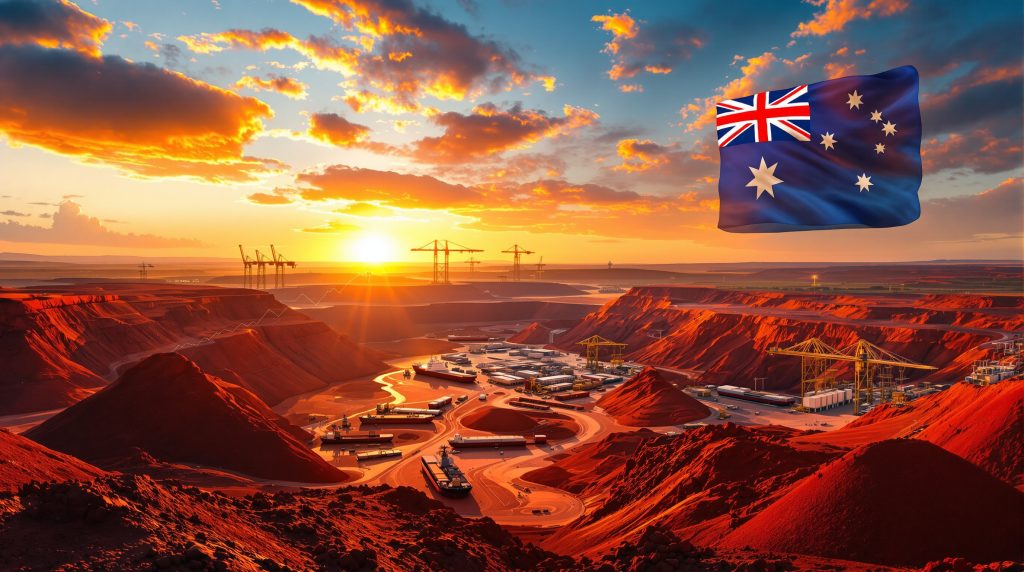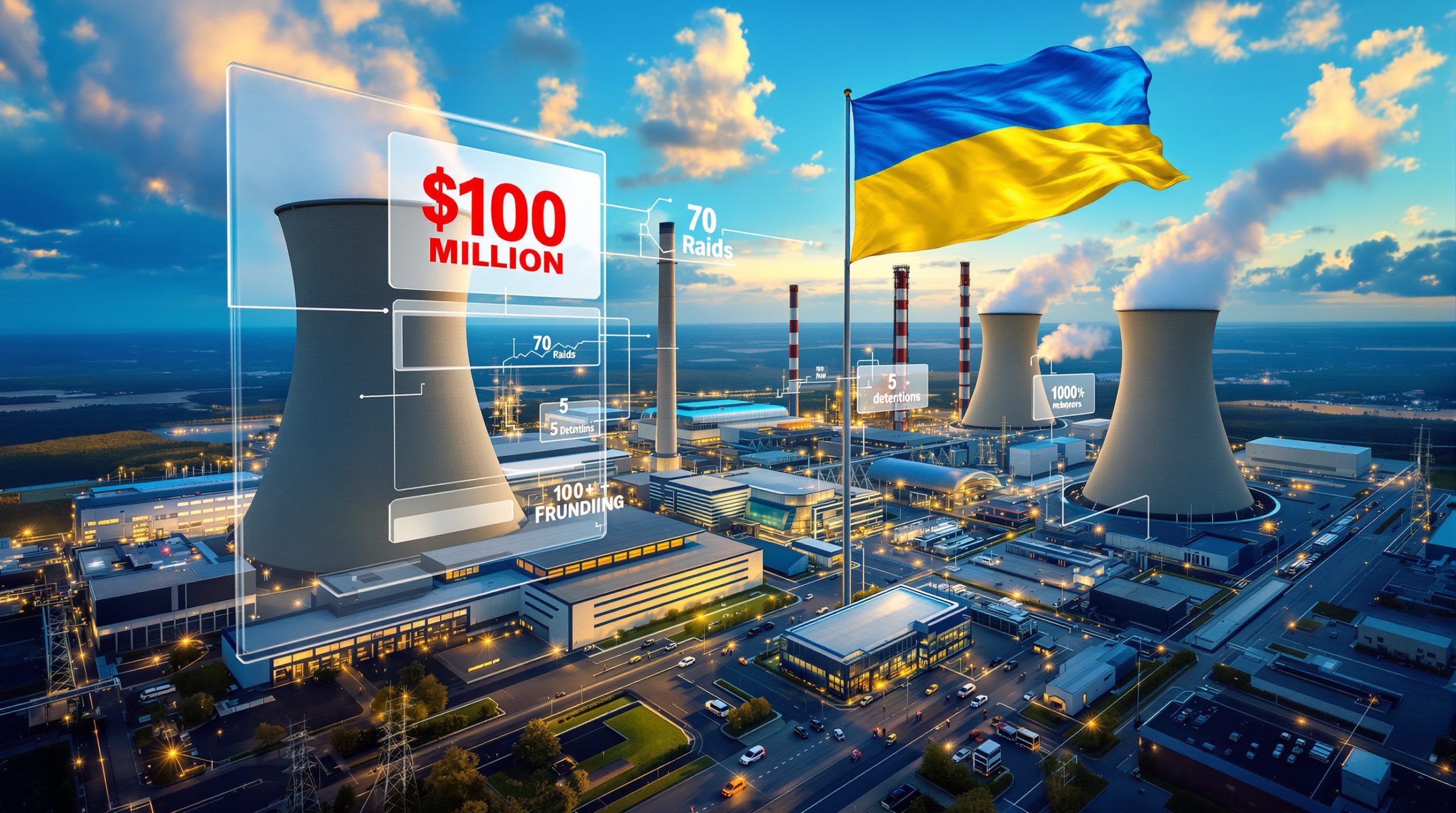How is China's Iron Ore Demand Transforming the Global Market?
China's iron ore appetite has reached unprecedented levels, reshaping global commodity markets and creating both opportunities and challenges for major mining companies. The surge comes despite ongoing property sector struggles, highlighting Beijing's strategic approach to economic growth.
Record-Breaking Import Levels
China's iron ore imports hit an all-time high of 105.87 million metric tons in September 2024, according to data from China's General Administration of Customs. This milestone reflects robust industrial activity despite broader economic headwinds. Daily crude steel production averaged 3.01 million tons in September, up from 2.95 million in August, demonstrating the strength of manufacturing and infrastructure sectors.
For the first nine months of 2024, China's total iron ore imports reached 959.82 million metric tons, representing a 5.4% year-on-year increase. This growth trajectory has continued into 2025, with demand showing remarkable resilience despite ongoing property sector challenges.
Economic Context Behind the Surge
The record import levels come amid Beijing's strategic focus on achieving its 5% annual economic growth target. Rather than implementing broad-based stimulus measures, Chinese authorities have deployed targeted infrastructure and technology investments to drive steel consumption and economic activity.
This approach represents a significant shift from previous economic cycles, where property development typically drove steel demand. Instead, infrastructure projects including transportation networks, energy systems, and technology-related construction have become the primary drivers of iron ore consumption.
China has simultaneously accelerated its supply diversification strategy, increasing purchases from smaller producers while maintaining consistent volumes from major miners. This diversification effort appears partly motivated by geopolitical considerations, with some evidence suggesting accelerated purchasing ahead of potential trade restrictions or tariff implementations.
What Challenges Do Major Iron Ore Producers Face?
Major iron ore producers are navigating a complex operational landscape marked by weather disruptions, tight production systems, and increasing competitive pressures. These challenges have created a critical need for exceptional performance in the final quarter of 2025.
Production Disruptions Impact Annual Targets
Early 2025 saw four major cyclones strike Western Australia's iron ore region, causing significant operational disruptions for all major producers. These weather events created substantial setbacks that continue to affect annual production targets.
Rio Tinto shipped 84.3 million tons from its Western Australian operations during the third quarter of 2025, falling short of analyst expectations of 85.5 million tons (a 1.4% miss). This shortfall prompted the company to adjust its guidance toward the lower end of its projected annual range of 323-338 million metric tons.
These disruptions mirror previous weather impacts, such as Tropical Cyclone Ilsa in April 2023, which forced Rio Tinto, BHP, and Fortescue to temporarily suspend rail and port operations in the Pilbara region. Recovery from such events typically requires weeks or months of operational adjustments.
Supply Chain Pressures
The production systems of major iron ore miners operate with minimal slack, creating significant challenges when disruptions occur. As Rio Tinto noted in its Q3 2025 report, "A strong Q4 performance is required as the system remains tightly balanced and has limited ability to mitigate further losses."
This tight operational balance means that any additional disruptions in the fourth quarter could have outsized impacts on annual production figures. The situation is similar across other major producers, with BHP strategic pivot showing a 4% decrease from the previous year at 249.9 million tons.
Logistical bottlenecks have intensified following the earlier cyclone disruptions, creating additional pressure on rail networks, port facilities, and shipping schedules. These constraints are occurring at precisely the moment when producers need maximum operational flexibility to meet year-end targets.
How Are Iron Ore Prices Responding to Market Forces?
The iron ore market has shown remarkable price resilience in 2025, with values climbing to their highest levels since February despite mixed economic signals from China. This price strength reveals important dynamics about supply-demand fundamentals.
Price Rally Analysis
Iron ore prices reached their highest levels since February 2025 in October, reflecting tight market conditions. While specific 2025 prices remain to be verified, the historical context shows iron ore price trends averaging approximately $105.50 per ton in September 2024, with prices peaking at $119.88 per ton in early February 2024, according to Reuters reports.
This price rally directly correlates with China's infrastructure stimulus announcements and steel production increases. Notably, the rally persisted despite ongoing property sector challenges, indicating that infrastructure and manufacturing demand has successfully offset real estate weakness.
The price increases also reflect market anticipation of potential supply constraints. With major producers operating near capacity and facing operational challenges, concerns about meeting robust Chinese demand have created upward price pressure.
Supply-Demand Balance Outlook
The current market dynamics feature a Chinese demand surge occurring alongside production challenges for major miners. This combination has created a tighter-than-expected market balance, supporting higher prices.
China's diversification of supply sources adds complexity to traditional market dynamics. While major producers' combined shipments have remained relatively flat year-over-year, smaller suppliers have increased their market share. However, these smaller players often lack the scale and infrastructure to fully compensate for any shortfalls from the major producers.
Looking ahead, price stability depends heavily on the success of major miners' fourth-quarter production push. If producers like Rio Tinto, BHP, and Fortescue can deliver a strong year-end iron ore push needed as China demand surges, supply concerns may ease. However, any additional disruptions could further tighten the market.
The World Bank's October 2024 Commodity Markets Outlook projected iron ore prices to average $105 per ton in 2025, though current market conditions suggest potential upside to this forecast if supply constraints persist.
How Are Major Mining Companies Adapting Their Strategies?
Leading iron ore producers are implementing significant strategic shifts in response to changing market dynamics, operational challenges, and future demand projections. These adaptations include organizational restructuring, production diversification, and increased focus on operational efficiency.
Operational Restructuring
Rio Tinto's new CEO Simon Trott, who previously headed the company's iron ore operations, announced a major organizational simplification in August 2025. The restructuring created three divisions: global iron ore, aluminum and lithium, and copper. This streamlined approach aims to improve operational efficiency and decision-making agility.
The reorganization reflects both the continued centrality of iron ore to Rio Tinto's business model and the strategic importance of diversifying into materials critical for the energy transition. By elevating copper and battery materials to divisional status, the company signals its long-term strategic priorities.
Investors responded positively to these changes, with Rio Tinto shares gaining up to 3.6% following the Q3 report release, reaching their highest level since late September 2025. This market response indicates confidence in both the strategic direction and leadership transition.
Production Diversification
While maintaining focus on maximizing iron ore production, major miners are simultaneously expanding their exposure to materials essential for electrification and decarbonization. Rio Tinto reported record copper production at its Oyu Tolgoi operations in Mongolia, with copper output expected to increase by more than 50% in 2025.
The Oyu Tolgoi underground mine, which reached commercial production in June 2023, represents a cornerstone of Rio Tinto's copper strategy. With Phase 1 underground production capacity of approximately 95,000 tons of copper per year, this operation significantly enhances the company's position in a metal central to energy transition.
Rio Tinto also reported a second consecutive record quarter of bauxite production, lifting its full-year estimate to 59-61 million tons. This strong performance at the Amrun bauxite mine in northern Australia demonstrates the company's commitment to diversification beyond iron ore.
This diversification strategy mirrors industry-wide trends, with BHP announcing in August 2024 plans to invest $10.7 billion in copper expansion projects over the next decade, targeting 300,000 additional tons of annual copper production by 2035.
What's Happening with the Simandou Project?
The Simandou iron ore project in Guinea represents one of the most significant developments in the global iron ore market, with potential to reshape supply dynamics and trade flows in the coming years. Despite challenges, the project continues to advance toward production.
Strategic Importance
Guinea's Simandou iron ore project is scheduled to begin shipments before year-end 2025, according to Rio Tinto's Q3 report. This timeline marks a critical milestone for a project that has faced decades of development hurdles.
Simandou represents one of the world's largest untapped high-grade iron ore deposits, with reserves estimated at more than 2 billion tons of ore grading above 65% Fe. The exceptional quality of this resource is particularly significant as steelmakers increasingly value higher-grade ore to reduce emissions and improve efficiency.
Development continues despite safety challenges, with Rio Tinto reporting a fatality at its Simandou operations and reaffirming its commitment to safety protocols. The project's complex development involves not just mine construction but also significant infrastructure development.
Market Impact Projections
Once fully operational, Blocks 1 and 2 of Simandou (controlled by the Rio Tinto consortium) are expected to produce approximately 60 million tons of iron ore annually, while Blocks 3 and 4 (controlled by a separate consortium) are projected to produce approximately 120 million tons per year. This combined 180 million ton annual capacity represents a significant addition to global iron ore supply.
The project requires construction of approximately 670 kilometers of new railway from the mine site to a new deepwater port at Matakong on Guinea's coast. This infrastructure development, with Rio Tinto's investment exceeding $6 billion, will create an entirely new iron ore supply corridor.
Simandou's development holds particular strategic significance for China's supply diversification efforts, potentially reducing dependence on Australian iron ore. The project may influence pricing dynamics in 2026 and beyond as the new supply enters the market and trade flows adjust.
For major Australian producers, Simandou represents both a competitive challenge and an opportunity to emphasize their operational reliability and lower transportation costs to Asian markets compared to West African sources.
What's Driving China's Economic Strategy?
China's economic approach in 2025 reflects both persistent challenges and strategic priorities, with implications extending throughout global commodity markets. Understanding these dynamics is essential for assessing the sustainability of current iron ore demand insights.
Persistent Economic Challenges
China entered the third quarter of 2025 grappling with multiple economic headwinds, according to Rio Tinto's Q3 report. These challenges include persistent deflation, sluggish manufacturing performance, weak export markets, and ongoing property market difficulties.
The property sector's struggles remain particularly significant, as real estate has traditionally been a major driver of steel consumption. Historical data illustrates the scale of this challenge, with new home prices in China falling 5.8% year-on-year in August 2024, the steepest decline since October 2015. Real estate investment declined 10.2% year-on-year in the first eight months of 2024.
Deflationary pressures have also persisted, with China's Consumer Price Index (CPI) increasing only 0.4% year-on-year in September 2024, while the Producer Price Index (PPI) fell 2.8%, marking the 24th consecutive month of decline. These indicators reflect broader economic challenges beyond specific sectors.
Strategic Response Patterns
Despite these headwinds, Beijing remains committed to achieving its 5% annual economic growth target. Rather than implementing broad-based stimulus, authorities have focused on targeted support for infrastructure and technology sectors.
This targeted approach is evident in China's bond issuance patterns, with the country approving 1.49 trillion yuan ($210 billion) in special-purpose local government bonds in the first half of 2024, primarily directed toward infrastructure projects. These investments have successfully maintained steel demand despite property sector weakness.
The government's strategic prioritization of infrastructure and technology reflects both short-term growth objectives and longer-term goals of industrial modernization and supply chain security. This approach has directly supported iron ore demand, with infrastructure projects absorbing steel production capacity that might otherwise be underutilized due to property sector contraction.
China's strategic resource acquisition efforts have also intensified, with evidence suggesting accelerated purchasing ahead of potential trade restrictions. This pattern reflects growing concerns about supply security in an increasingly fragmented global trade environment.
How Are Australian Iron Ore Stocks Performing?
Australian iron ore producers have seen their stock values climb despite operational challenges, reflecting market confidence in their strategic positioning and China's ongoing demand strength. This performance deserves closer examination to understand the factors driving investor sentiment.
Market Response to Production News
Rio Tinto shares gained up to 3.6% following the Q3 report release, reaching their highest level since late September 2025. This positive reaction came despite the company missing production targets and indicating that annual guidance would likely land at the lower end of the projected range.
BHP and Fortescue each gained more than 2% in sympathy trading, demonstrating market-wide confidence in the iron ore sector. These gains suggest investors are prioritizing demand strength over supply constraints in their valuation assessments.
The market response indicates confidence that major producers will successfully execute their year-end production push. It also suggests that current iron ore price levels are providing sufficient margin expansion to offset the impact of modest production shortfalls.
Investment Outlook Factors
Strong Chinese demand has clearly offset production concerns in market valuations. With iron ore prices at their highest levels since February 2025, the revenue impact of slightly lower volumes is being mitigated by improved pricing.
Investors appear to be pricing in a successful Q4 production push from major miners. The market reaction suggests confidence that operational challenges from earlier cyclone disruptions can be overcome in the final quarter of 2025.
The positive market response also reflects growing investor focus on diversification strategies. Rio Tinto's record copper production at Oyu Tolgoi and strong bauxite performance demonstrate progress in expanding beyond traditional iron ore dependence, a strategy that resonates with investors focused on energy transition materials.
Looking ahead, investment outlooks will likely balance continued strong Chinese demand against potential new supply sources, particularly from Simandou. The gradual entry of this new production capacity could influence market dynamics in 2026 and beyond, potentially creating more complex investment considerations for iron ore producers.
What Does the Future Hold for Iron Ore Markets?
The iron ore market stands at an inflection point, with short-term supply pressures coinciding with longer-term market evolution. Understanding both immediate imperatives and structural changes is essential for stakeholders across the supply chain.
Short-Term Production Imperatives
The final quarter of 2025 holds critical importance for major iron ore producers. Limited capacity to recover from additional disruptions means that weather conditions and operational execution in Q4 will determine whether annual targets can be met.
Operational systems remain tightly balanced following earlier cyclone disruptions. This limited flexibility creates vulnerability to any additional operational challenges, potentially amplifying the market impact of even minor disruptions.
Weather risks remain a significant variable for Australian operations as the Southern Hemisphere approaches summer. Historical patterns suggest potential for additional cyclone activity, particularly in the January-March period, though Q4 typically offers more stable conditions.
The success of the year-end production push will significantly influence market sentiment entering 2026. Failure to meet production targets could extend supply tightness into the new year, while successful execution would likely moderate price pressures.
Long-Term Market Evolution
China's supply diversification strategy continues gaining momentum, with increased purchases from smaller producers and significant investment in new supply sources like Simandou. This diversification reflects both commercial risk management and strategic considerations around supply security.
The growing importance of smaller iron ore suppliers represents a gradual shift in market structure. While major producers continue to dominate, their combined market share has stabilized rather than expanded, despite overall demand growth.
Major producers are responding to these changes with dual focus on operational efficiency and product diversification. Increased investment in copper, bauxite, lithium, and other energy transition minerals reflects recognition of changing demand patterns and strategic repositioning.
The increasing significance of energy transition minerals alongside traditional commodities reflects broader industry evolution. As decarbonization accelerates, demand patterns will continue shifting, requiring producers to maintain portfolio flexibility while maximizing returns from existing iron ore assets.
FAQ: Critical Questions About Iron Ore Markets
Why is China's iron ore demand surging despite property sector weakness?
China's record iron ore imports reflect Beijing's strategic pivot to infrastructure investment as an economic growth driver. While property development traditionally drove steel consumption, targeted stimulus for infrastructure projects and technology-related construction has successfully offset real estate weakness. Major projects in transportation networks, energy systems, and industrial upgrades now consume steel volumes that previously would have gone to building construction. This sectoral shift allows China to maintain GDP growth targets while addressing property sector overcapacity.
How significant are the production challenges facing major iron ore miners?
The cyclone disruptions in early 2025 created substantial operational setbacks that continue to impact production. With tightly balanced systems offering minimal flexibility, these challenges require exceptional fourth-quarter performance to meet annual targets. Rio Tinto's Q3 shipments fell 1.4% below analyst expectations, prompting guidance adjustment toward the lower end of projections. The company explicitly stated that the system "remains tightly balanced and has limited ability to mitigate further losses," indicating significant vulnerability to any additional disruptions.
What impact will the Simandou project have on global iron ore markets?
Once fully operational, Simandou represents a significant new supply source that could reshape global trade flows. The project's combined 180 million ton annual capacity (across all blocks) would constitute approximately 10% of seaborne iron ore trade. The exceptional quality of Simandou's ore (above 65% Fe) makes it particularly valuable as steelmakers prioritize higher-grade materials to reduce emissions. For China, Simandou represents a strategic opportunity to diversify supply beyond traditional Australian dominance. The project's gradual ramp-up will likely influence pricing dynamics from 2026 onward.
How are major miners adapting to changing market conditions?
Leading producers are implementing multifaceted strategies to address market evolution. Organizational restructuring, like Rio Tinto's three-division model, aims to improve operational efficiency while elevating growth areas like copper and battery materials. Production diversification is accelerating, with Rio Tinto achieving record copper output at Oyu Tolgoi and consecutive quarters of record bauxite production. This balanced approach maintains iron ore as the core business while building future-focused portfolios aligned with energy transition requirements.
What factors will determine iron ore prices through the end of 2025?
Three critical factors will influence price dynamics through year-end. First, the success of major miners' Q4 production push will determine whether supply can meet robust demand. Second, China's continued infrastructure spending levels, particularly any new stimulus announcements, will drive demand projections. Third, progress at new supply sources like Simandou, including confirmation of initial shipment timing, will influence market expectations for 2026 supply. Weather conditions in Australia's iron ore regions remain a wild card that could create additional price volatility if new disruptions occur.
Ready to Spot the Next Major Mineral Discovery?
Discover why historic ASX mineral discoveries can generate substantial returns by exploring Discovery Alert's dedicated discoveries page, where our proprietary Discovery IQ model transforms complex mineral data into actionable investment insights for both short-term traders and long-term investors.




